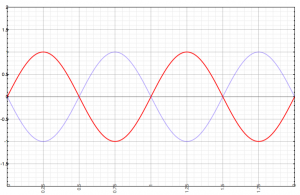One of my readers asked a good question and I thought we should answer it.
His question was a simple one. Why does some equipment invert phase? Seems simple enough to NOT invert phase, since most equipment doesn't.
First, let's remember what inverting phase means, and get the correct terminology. What we should be saying is inverting
polarity, not phase, but frankly, I prefer phase because it's a term understood by more people than not.
Here's a picture of what we're talking about.

In this photo the red line is
in phase, the purple line,
out of phase. As the red line is moving up, the purple line is moving down. What's that all mean in practical terms?
Connected to a loudspeaker, the red line moves the woofer towards the listener as it moves up, and away when it drops down below the center line on the diagram. If the original musical signal moved one way, you'd want your speaker to duplicate its movement and direction.
The most common reason a preamplifier or power amplifier might invert phase has to do with its very design. The simplest designs commonly invert phase. Take a look at this diagram.

This is a schematic for a single stage tube preamplifier (it could also be solid state). It's like many preamplifiers that focus their design efforts on the simplest path possible. None could be simpler than a single gain stage, but the penalty you pay for keeping it simple is phase inversion. With few exceptions, high input impedance single stage amplifiers invert phase. It's just how they work and there's not much you can do. Designers than want to fix the problem are forced to add a second stage that also inverts, thus, two inverts in a row make a non-invert.
It is this type of simple circuit that causes some of the most expensive preamps ever made to invert phase at their output.
 In this photo the red line is in phase, the purple line, out of phase. As the red line is moving up, the purple line is moving down. What's that all mean in practical terms?
Connected to a loudspeaker, the red line moves the woofer towards the listener as it moves up, and away when it drops down below the center line on the diagram. If the original musical signal moved one way, you'd want your speaker to duplicate its movement and direction.
The most common reason a preamplifier or power amplifier might invert phase has to do with its very design. The simplest designs commonly invert phase. Take a look at this diagram.
In this photo the red line is in phase, the purple line, out of phase. As the red line is moving up, the purple line is moving down. What's that all mean in practical terms?
Connected to a loudspeaker, the red line moves the woofer towards the listener as it moves up, and away when it drops down below the center line on the diagram. If the original musical signal moved one way, you'd want your speaker to duplicate its movement and direction.
The most common reason a preamplifier or power amplifier might invert phase has to do with its very design. The simplest designs commonly invert phase. Take a look at this diagram.
 This is a schematic for a single stage tube preamplifier (it could also be solid state). It's like many preamplifiers that focus their design efforts on the simplest path possible. None could be simpler than a single gain stage, but the penalty you pay for keeping it simple is phase inversion. With few exceptions, high input impedance single stage amplifiers invert phase. It's just how they work and there's not much you can do. Designers than want to fix the problem are forced to add a second stage that also inverts, thus, two inverts in a row make a non-invert.
It is this type of simple circuit that causes some of the most expensive preamps ever made to invert phase at their output.
This is a schematic for a single stage tube preamplifier (it could also be solid state). It's like many preamplifiers that focus their design efforts on the simplest path possible. None could be simpler than a single gain stage, but the penalty you pay for keeping it simple is phase inversion. With few exceptions, high input impedance single stage amplifiers invert phase. It's just how they work and there's not much you can do. Designers than want to fix the problem are forced to add a second stage that also inverts, thus, two inverts in a row make a non-invert.
It is this type of simple circuit that causes some of the most expensive preamps ever made to invert phase at their output.








